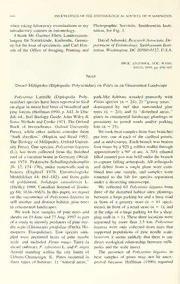
DWARF MILLIPEDES (DIPLOPODA : POLYXENIDAE) ON PINES IN AN ORNAMENTAL LANDSCAPE PDF
Preview DWARF MILLIPEDES (DIPLOPODA : POLYXENIDAE) ON PINES IN AN ORNAMENTAL LANDSCAPE
696 PROCEEDINGS OF THE ENTOMOLOGICAL SOCIETY OF WASHINGTON when taking laboratory examinations in my Photographic Services, Smithsonian Insti- introductory courses in entomology. tution, for Fig. 1. I thank Mr. Guenter Ebert, Landessamm- lungen fUr Naturkunde, Karlsruhe, Germa- David Adamski, Research Associate, De- ny for the loan ofspecimens, and Carl Han- partment ofEntomology, Smithsonian Insti- DC sen of the Office of Imaging, Printing and tution, Washington, 20560-0127, U.S.A. PROC. ENTOMOL. SOC. WASH. 101(3), 1999, pp. 696-697 Note Dwarf Millipedes (Diplopoda: Polyxenidae) on Pines in an Ornamental Landscape Polyxenus Latreille (Diplopoda: Poly- park-like habitats wooded primarily with xenidae) species have been reported to feed Pinus species (n = 24); 2) "grassy areas," on algae in moist leaflitter ofbroadleafand dominated by turf that surrounded pine pine forests (Hoffman 1990, p. 842. In Din- trees (n = 24); and 3) "disturbed areas," dal, ed.. Soil Biology Guide. John Wiley & pines in ornamental landscape plantings in Sons; Nichols and Cooke 1971. The Oxford proximity to paved roads and/or parking Book of Invertebrates. Oxford University lots (n = 25). Press), while other authors consider them We took beat samples from four branches "bark dwellers" (Hopkin and Read 1992. per tree, one at each of the cardinal points, The Biology of Millipedes, Oxford Univer- and at mid-canopy. Each branch was beaten sity Press). One species, Polyxenus lagurus four times by a 925 g rubber mallet through (L.), has been collected from the thatched approximately a 90° of arc. A 70% ethanol roofof a vacation home in Germany (Weid- filled enamel pan was held underthe branch ner 1974. Praktische-Schadlingsbekampfer to capture falling arthropods. All arthropods 26: 12, 174-176), under stonewalls and in and debris from a single plant were com- houses (Enghoff 1976. Entomologiske bined into one sample, and samples were Meddelelser 44: 161-182), and from galls returned to the lab for species separation of goldenrod, Solidago canadensis L. under a dissecting microscope. (Shelley 1988. Canadian Journal of Zoolo- We collected 63 Polyxenus lagurus from gy 66: 1638-1663). In this paper, we report three of the disturbed habitat sites: plantings on the occurrence of Polyxenus lagurus in between a large parking lot and a busy road still another and distinct habitat, pine trees in front of a grocery store (n = 61 speci- in ornamental landscapes. mens), in front of a retail store (n = 1), and We took beat samples of pine trees and at the edge of a large parking lot for a shop- shrubs on 19 June and 27 Aug. 1997 as part ping mall (n = 1). These three locations were of a study to identify predators ofpine nee- separated by more than 3.5 km. Polyxenus dle scale (Chionaspispinifoliae (Fitch); Ho- lagurus were only collected from trees that moptera: Diaspididae). Tree species sam- supported populations of pine needle scale; pled were preferred hosts of pine needle however, it seems unlikely that there is any scale and included Pinus mugo Turra (a direct ecological relationship between milli- dwarfcultivar), P. sylvestris L. and P. nigra pedes and the scale insect. Arnold standing within the city limits of The presence of Polyxenus lagurus in Urbana-Champaign, IL. Pines occurred in beat samples of pines may not be unex- three types of habitats: 1) "natural areas," pected because Hoffman (1990) reported VOLUME 101, NUMBER 3 697 — that a few species of Polyxenus occur in Acknowledgments. We thank M. N. pine forests, especially in the leaf litter, and Duy and J. B. Nardi for their assistance Hopkin and Read (1992) state that Polyxen- identifying specimens and E. R. Zaborski us are often bark-dwellers. It was surpris- for providing ecological information on ing, however, that the millipedes were not dwarf millipedes. present in the grassy or natural habitats that were higher in arthropod diversity than the John E Tooker and Lawrence M. Hanks, disturbed areas where they were collected Department of Entomology, University of (J. F. Tooker, unpublished data). Disturbed Illinois at Urbana-Champaign 320 Morrill areas may provide suitable habitats for Hall, 505 South Goodwin Avenue, Urbana, Polyxenus lagurus because of their dry mi- IL 61801-3707, U.S.A. (email: tooker@uiuc. croclimate (Hopkins and Read 1992) and edu) lower abundance of predaceous arthropods (J. E Tooker, unpublished data). PROC. ENTOMOL. SOC. WASH. 101(3). 1999. p. 697 Note A Type Species Designation for Actilasioptera Gagne (Diptera: Cecidomyiidae) I recently described a new genus named of the the International Code of Zoological Actilasioptera and included in it five new Nomenclature (Third Edition, 1985), a ge- species, all from grey mangrove in Austra- nus published after 1931 must be accom- lia (Gagne, R. J. and L. L. Law. 1999. Ac- panied by type fixation. Actilasioptera be- tilasioptera (Diptera: Cecidomyiidae), a comes valid as of the date ofpublication of new genus for Australasian and Asian gall this note and not the date of its formal de- midges of grey mangroves, Avicennia spp. scription (ICZN). (Avicenniaceae), pp. 22—35. /// Csoka, G., W. J. Mattson, G. N. Stone, and R W. Price, Raymond J. Gagne, Systematic Entomol- eds. The Biology of Gall-Inducing Arthro- ogy Laboratory, PSIAgricultural Research % pods. U.S. Department of Agriculture For- Serx'ice, U.S. Department ofAgriculture, est Service General Technical Report NO- National Museum of Natural History, DC 199). I neglected to designate a type species Smithsonian Institution, Washington, there so do so now, viz.,Actilasioptera tuni- 20560-0168, U.S.A. (e-mail: rgagne@sel. idifolium Gagne. According to Article 13b barc.usda.gov). PROC. ENTOMOL. SOC. WASH. 101(3), 1999, p. 697-698 Note Notes on Chilean Orussidae (Hymenoptera) and a Probable New Host Association Orussidae is the only entomophagous fam- University of California Publications, Vol. ily of Symphyta. Records associate species 101, 46 pp.) gave a good summary ofknown with wood-boring Coleopotera and Hyme- biological information. noptera. Middlekauff (1983. Entomology, Two species of Orussidae have been re-
